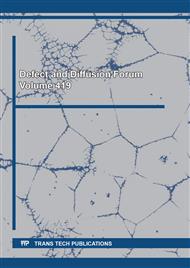[1]
W. Sobek, Glass structures, Struct. Eng. 83(7) (2005) 32-36.
Google Scholar
[2]
H. S. Norville, K.W. King, J L. Swofford, Behavior and strength of laminated glass, J. Eng Mech 124(1) (1998) 46-53.
DOI: 10.1061/(asce)0733-9399(1998)124:1(46)
Google Scholar
[3]
C.V.G. Vallabhan, Y C. Das, M. Ramasamudra, Properties of PVB interlayer used in laminated glass, J. Mat. Civil Eng, 4(1) (1992) 71-77.
DOI: 10.1061/(asce)0899-1561(1992)4:1(71)
Google Scholar
[4]
D. Baraldi, A simple mixed finite element model for laminated glass beams, Compos. Struct, 194 (2018) 611-623.
DOI: 10.1016/j.compstruct.2018.03.028
Google Scholar
[5]
L. Galuppi, G. Royer-Carfagni, Effective thickness of laminated glass beams: New expression via a variational approach, Eng. Struct, 38, (2012) 53-67.
DOI: 10.1016/j.engstruct.2011.12.039
Google Scholar
[6]
M.N. Newmark, C.P. Siess, I.M. Viest, Tests and analysis of composite beams with incomplete interaction, Proceedings Society for Experimental Stress Analysis, New York, USA, 1951, vol. 9, no. 1, p.75–92.
Google Scholar
[7]
J.H. Nielsen, J. Belis, C. Louter, M. Overend, J. Schneider, Celebrating the international year of glass, Glass Struct. Eng, 7(1) (2022).
DOI: 10.1007/s40940-022-00173-1
Google Scholar
[8]
D. Baraldi, A simple mixed finite element model for composite beams with partial interaction, Compos. Mech. Comp. Appl. Int. J, 11(3) (2020) 187-207.
DOI: 10.1615/compmechcomputapplintj.2020034460
Google Scholar
[9]
D. Baraldi, N. Tullini, Incremental Analysis of Elastoplastic Beams and Frames Resting on an Elastic Half-Plane, J. Eng. Mech, 143(9) (2017) 04017101.
DOI: 10.1061/(asce)em.1943-7889.0001331
Google Scholar
[10]
R.A. Behr, J.E. Minor, M.P. Linden, Load duration and interlayer thickness effects on laminated glass, J. Struct. Eng, 112(6) (1986) 1441-1453.
DOI: 10.1061/(asce)0733-9445(1986)112:6(1441)
Google Scholar
[11]
S. Briccoli Bati, G. Ranocchiai, C. Reale, L. Rovero, Time-Dependent Behavior of Laminated Glass, J. Mater. Civil Eng, 22(4) (2010) 389-396.
DOI: 10.1061/(asce)mt.1943-5533.0000032
Google Scholar
[12]
S.T. Akter, M.S. Khani, Characterisation of laminated glass for structural applications, Master Thesis, Linneuniversitetet, (2013).
Google Scholar
[13]
G. Castori, E. Speranzini, Structural analysis of failure behavior of laminated glass, Compos. B Eng, 125 (2017) 89-99.
DOI: 10.1016/j.compositesb.2017.05.062
Google Scholar
[14]
D. Baraldi, A. Cecchi, P. Foraboschi, Broken tempered laminated glass: Non-linear discrete element modelling, Compos. Struct, 140 (2016) 278-295.
DOI: 10.1016/j.compstruct.2015.12.050
Google Scholar



